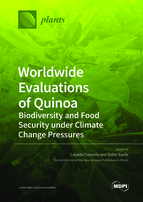Worldwide Evaluations of Quinoa—Biodiversity and Food Security under Climate Change Pressures
A special issue of Plants (ISSN 2223-7747).
Deadline for manuscript submissions: closed (31 March 2022) | Viewed by 108561
Special Issue Editors
Interests: soil water plant relations; abiotic stresses; agronomy; herbaceous crops; quinoa; amaranth
Special Issues, Collections and Topics in MDPI journals
2. UMR SENS, CIRAD, IRD, Univ. Paul Valery Montpellier 3, Univ. Montpellier, 34090 Montpellier, France
Interests: agrobiodiversity; agroecology; plant genetic resources for food and agriculture; quinoa; neglected and underutilized species; cropping systems; food security; adaptation to climate change
Special Issues, Collections and Topics in MDPI journals
Special Issue Information
Dear Colleagues,
Quinoa (Chenopodium quinoa Willd.) is a herbaceous plant domesticated more than 5000 years BP in the Andean region. The crop is characterized by very high biodiversity, which allows it to adapt easily considering the very different pedoclimatic conditions it faces, as well as makes it resistant to abiotic stresses and climate change proof. Moreover, quinoa is distinguished by its exceptional nutritional characteristics, such as the content and quality of proteins, minerals, lipids, and tocopherols. These features have determined, since the 1990s, the growing interest for quinoa crop by the scientific community and international organizations. In 2013, the United Nations Organization for Food and Agriculture (FAO) celebrated the “International Year of Quinoa” to valorize its biodiversity for fighting against food insecurity. Several experiments around the world have taken place in order to study the quinoa plant, thus evaluating the adaptability of different genotypes in new environments, and its response to various laboratory stimuli and cultivation best practices. This Special Issue aims at collecting the main recent studies developed on quinoa worldwide and at sharing further progress in the field.
Dr. Cataldo Pulvento
Dr. Didier Bazile
Guest Editors
Manuscript Submission Information
Manuscripts should be submitted online at www.mdpi.com by registering and logging in to this website. Once you are registered, click here to go to the submission form. Manuscripts can be submitted until the deadline. All submissions that pass pre-check are peer-reviewed. Accepted papers will be published continuously in the journal (as soon as accepted) and will be listed together on the special issue website. Research articles, review articles as well as short communications are invited. For planned papers, a title and short abstract (about 100 words) can be sent to the Editorial Office for announcement on this website.
Submitted manuscripts should not have been published previously, nor be under consideration for publication elsewhere (except conference proceedings papers). All manuscripts are thoroughly refereed through a single-blind peer-review process. A guide for authors and other relevant information for submission of manuscripts is available on the Instructions for Authors page. Plants is an international peer-reviewed open access semimonthly journal published by MDPI.
Please visit the Instructions for Authors page before submitting a manuscript. The Article Processing Charge (APC) for publication in this open access journal is 2700 CHF (Swiss Francs). Submitted papers should be well formatted and use good English. Authors may use MDPI's English editing service prior to publication or during author revisions.
Keywords
- quinoa
- biodiversity
- food security
- climate change
- screening
- best agronomic practices
- soil–water–plant relations
- environmental adaptability
- ecophysiological traits







